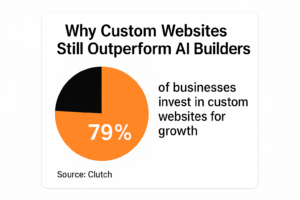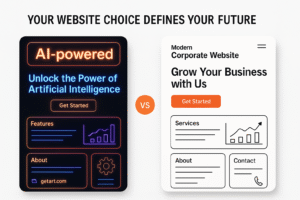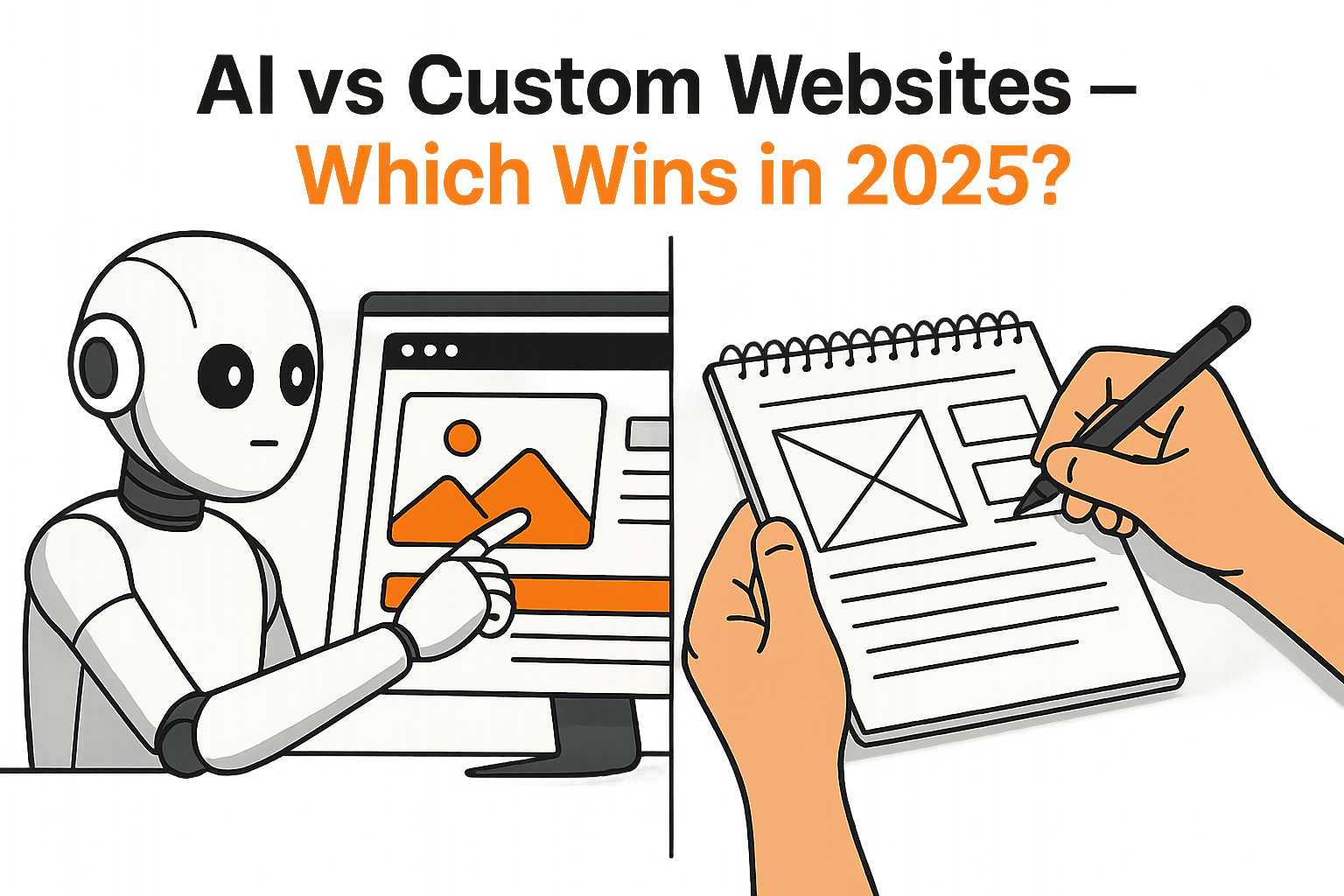AI-Assisted vs Custom Websites in 2025: Which is Best?
Sep 22, 2025 | By Ahmed Sohail
This writing aims to compare AI-assisted website builders and custom-designed websites, making a case that custom design leads to better business growth. It effectively presents a relatable anecdote, highlights pitfalls of AI websites, explains the benefits of custom sites with data, and ends with clear recommendations supported by case studies. The tone is persuasive, accessible, and motivating.
Strengths include its storytelling approach, logical structure with clear sections, strong use of statistics, and an engaging conclusion that motivates action.
Areas for improvement involve tightening some repetitive phrases, enhancing sentence flow for smoother reading, polishing grammar and punctuation, and refining transitions for a more professional tone while retaining a friendly voice.
Improved Version
AI vs. Custom Websites: Why 79% of Businesses Say Custom Design Wins for Growth

Last year, I met Priya, a small business owner who launched her online boutique using an AI-powered website builder. In just a few hours, her site was live. She was thrilled—no coding, no waiting, and only $20 a month.
Fast forward six months: her website looked almost identical to dozens of others, her sales flatlined, and competitors with custom sites were dominating search results. Frustrated, she asked the question many are asking today:
👉 Should I stick with an AI-assisted website, or invest in a custom-designed one?
This question is more relevant than ever in 2025. With AI tools like Wix ADI, GoDaddy AI Builder, and Google’s Gemini integrations, businesses can launch a website faster than ordering coffee. But speed and low cost don’t guarantee long-term success.
In this blog, we’ll dive into the AI vs. custom website debate, backed by data, case studies, and real-world results. By the end, you’ll know which option fits your business goals—and why custom websites remain the gold standard for growth.
The Problem — Why AI Websites Look Good but Often Fail
AI website builders promise quick, cheap, and easy solutions—and they deliver in the short term. However, most businesses outgrow their AI sites within 12–18 months.
Pain Point 1: Generic Templates
AI draws from pre-designed layouts, meaning your “digital storefront” likely resembles dozens of others. GoodFirms (2024) found 60% of AI-built sites had at least five lookalikes in the same industry.
Pain Point 2: Limited Customization
Want a unique checkout flow, subscription model, or gamified UX? AI platforms rarely support advanced features without costly third-party plugins, leading to higher expenses or platform switches.
Pain Point 3: SEO Challenges
SEO drives organic traffic, but AI builders often produce bloated, messy code. Search Engine Journal (2023) reported AI sites score 38% lower in Core Web Vitals than custom-coded sites.
Pain Point 4: Scaling Roadblocks
AI sites suit small visitor volumes but falter as business grows. Google Cloud (2024) revealed 42% of small businesses using AI builders had to rebuild their sites within two years to scale effectively.
Why AI Falls Short
AI Uses Pre-Trained Patterns
AI assembles websites using data from thousands of past designs, making uniqueness nearly impossible. For example, two restaurants miles apart might have almost identical homepages.
One-Size-Fits-All Model
AI targets average users, not unique business goals. If you run a luxury fashion brand or B2B SaaS company, “average” won’t cut it.
SEO Blind Spots
AI suggests keywords but often misses technical SEO like schema markup, clean code, and intent-based optimization. Clutch (2024) found custom sites generate 2.4x more organic traffic growth in their first year.
The Solution — Why Custom Websites Deliver Long-Term ROI
A custom website isn’t just prettier—it’s a business growth engine.
Tailored Branding Builds Trust
Your website is often your first impression. Forbes (2024) discovered custom sites yield 33% higher customer trust scores than AI-template sites.
Built to Scale
Custom sites integrate complex features—CRM, AI chatbots, multi-currency payments—with ease. Gartner (2024) notes custom sites outperform AI builders by 3x when handling 50,000+ monthly visitors.
SEO Superiority
Custom sites allow deep technical optimization. Ahrefs (2024) found they rank 41% faster for competitive keywords than AI sites.
Higher Conversions
Custom designs focus on sales funnels with strategic layouts and A/B testing. Unbounce (2023) reported custom sites achieve 2-3x higher conversion rates.
Expanded Comparison Table
| Feature / Category | AI-Assisted Website (e.g., Wix AI, GoDaddy AI, Gemini-like) | Custom Designed Website |
|---|---|---|
| Initial Cost | Low to Medium — typically $10–$50/month subscription, sometimes with free trials. | High upfront ($2,000 – $20,000+ depending on complexity) but no platform lock-in fees long-term. |
| Speed to Launch | Very fast — functional site can be live within hours. | Slower — typically 4 to 12 weeks depending on scope and revisions. |
| Design Flexibility | Limited — restricted to available templates and drag-and-drop elements. | Unlimited — fully custom UI/UX tailored to brand goals and user journeys. |
| Branding & Uniqueness | Generic — many elements are reused across sites; harder to stand out. | Unique — crafted to reflect brand identity, voice, and values. |
| Content Generation | AI auto-generates text, images and layouts — faster but often generic in tone. | Human-written content — brand voice, story-driven copy, and SEO-focused writing. |
| Functionality & Features | Restricted — advanced features typically require plugins or are unsupported. | Unlimited — custom coding allows any feature, complex integrations, automations. |
| SEO Optimization | Basic — automated metadata and limited control over technical SEO; code may be bloated. | Advanced — full control (schema, Core Web Vitals, structured data, clean code). |
| Performance & Speed | Variable — depends on platform; can struggle with heavy traffic or many plugins. | Optimized — performance-tuned code, CDN-ready, and fine-tuned for speed. |
| Scalability | Poor — growth often forces migration or rebuild to a custom platform. | Excellent — built to handle growth, integrations, and higher traffic loads. |
| Security | Platform-managed security — good for basic needs but limited customization for enterprise compliance. | Customizable — enterprise-grade security, compliance options (GDPR, SOC2, HIPAA where needed). |
| Maintenance | Easy — platform updates are automatic; little technical knowledge required. | Developer/agency-managed — requires technical upkeep but gives full control and proactive optimizations. |
| Ownership & Control | Limited — the site is tied to the platform; full export/migration may be restricted. | Full ownership — code, data and hosting are controlled by you or your provider. |
| Third-Party Integrations | Limited to platform-supported plugins & APIs. | Unlimited — custom APIs, CRMs, ERPs, analytics and bespoke tools can be integrated. |
| Support | Generic platform helpdesk or chatbot support. | Dedicated agency or developer support with SLAs and custom SLAs available. |
| Conversion Optimization | Lower — generic UX and limited A/B testing features. | Higher — data-driven UX, A/B testing, CRO practices and tailored funnels. |
| Lifespan | Short — often replaced or rebuilt in 1–2 years as needs evolve. | Long-term — with updates can last 5–7 years or more. |
| Best For | Solopreneurs, MVPs, personal portfolios, temporary landing pages. | Established businesses, high-volume e-commerce, SaaS, enterprises and brands focused on growth. |
| Note: Choose based on your goals — speed and budget (AI-assisted) vs. long-term growth and control (custom). | ||
Case Studies — Real Success Stories
Fashion Brand Transformation
A boutique started with Wix AI Builder but stalled at 500 monthly visitors. After migrating to a custom Shopify site with SEO, sales rose 270% in 12 months, bounce rate dropped from 62% to 35%, and repeat customers doubled.
B2B SaaS Company
A SaaS firm’s GoDaddy AI site had poor conversions. Switching to a custom Next.js site doubled inbound leads, reduced bounce rates by 47%, and placed five high-intent keywords in the top 10.
These cases are not exceptions—they’re evidence.
Who Should Choose What?
Best for AI-Assisted Websites:
-
Solopreneurs testing ideas
-
Side projects and portfolios
-
Budget-conscious startups needing quick MVPs
-
Simple brochure sites
Best for Custom Websites:
-
Established businesses scaling operations
-
High-volume e-commerce stores
-
Professional services needing trust and credibility
-
Companies with advanced feature requirements
Conclusion — Renting vs. Owning Your Digital Future

Think of it like this:
AI Website = Renting an apartment. Quick and cheap but limited in customization and growth.
Custom Website = Owning a home. An investment built for you, scalable and valuable over time.
If you only want to exist online, AI sites will do. But if you want to grow, scale, and dominate, custom design is the clear choice.
According to Clutch (2024), 78% of businesses investing in custom websites report higher long-term ROI than those relying on AI platforms.
👉 Priya found this too—after moving to a custom site, her boutique’s sales grew by 180% in under a year.
So, ask yourself: Are you building a placeholder, or your brand’s digital future?
👉 Ready to build a website that drives growth? At Ahmed Sohail – Digital Marketing & IT Staff Augmentation Agency, we specialize in custom websites that scale, while guiding startups who want to start lean with AI.
Let’s talk about your project today.

Want to grow your business online?
I’m Ahmed Sohail, and I’m helping businesses grow with determined results. My question is, does your business needs growth?
Contact Now

